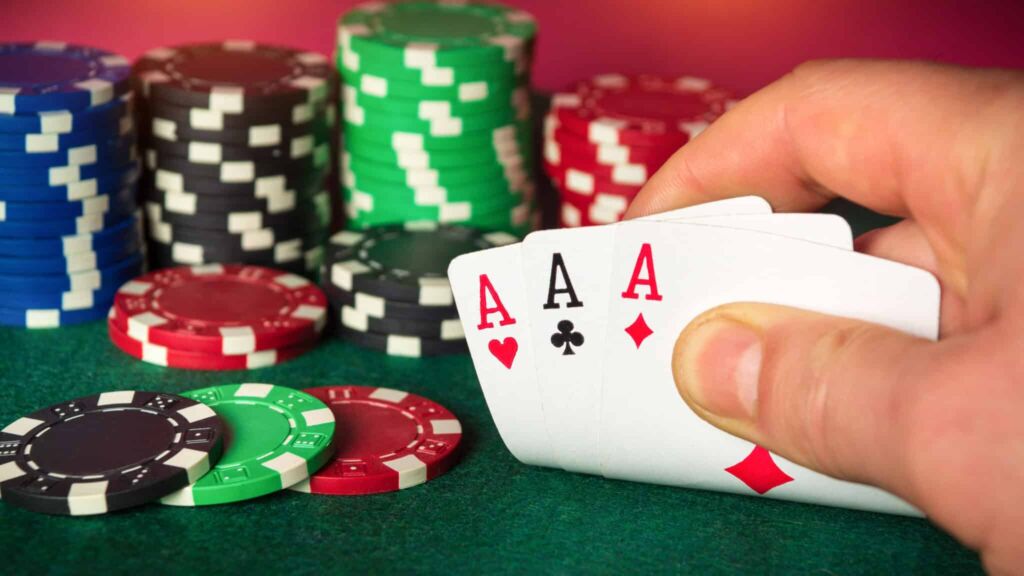Achieving consistent victories in poker isn't just about the cards you hold; it's equally about mastering the psychological nuances that make poker a game of intellect and skill, rather than mere luck.
Building a Strong Mental Game: Controlling Emotions at the Poker Table
The concept of emotional control in poker, often referred to as having a 'mental fortress,' is crucial. It involves keeping your cool even when the pressure mounts, making rational decisions despite the ups and downs of the game. Emotions in poker can lead to predictable patterns and give skilled opponents an advantage. The key is to make decisions driven by logic, not emotions, fostering a mental state where fear and frustration don't cloud your judgment.
Handling Emotional Fluctuations: Identifying and Addressing Tilt in Poker
Tilt, an emotional response from losses or unexpected outcomes, can disrupt a poker player’s focus and strategy, leading to reckless plays. Recognizing tilt is vital, with signs such as impatience and straying from strategies. Combating this involves breaks, mindfulness, and mental preparation, with techniques like meditation helping maintain control after tough games, preventing minor setbacks from escalating.
Managing Impulses: Making Calculated Poker Decisions
Impulse control is essential in poker, allowing players to opt for well-considered strategies over knee-jerk reactions. Whether tempted by a seemingly attractive bluff or frustration over a missed opportunity, disciplined players pause to evaluate the situation. They make decisions that align with long-term gains rather than seeking instant gratification, like folding against a seemingly strong opponent’s bet by carefully weighing odds and strategies.
Understanding Opponents: Analyzing Verbal and Physical Signals
In poker, players are not just rivals; they provide clues through their actions and words, which can be like an open book to those who know how to read it. The ability to pick up on these cues forms a fundamental part of gaining a competitive edge, helping assess an opponent’s hand strength or emotional state, leading to better strategic decisions on the table.
Body Language Insights: Picking up on Nonverbal Poker Signals
Nonverbal signals in poker can reveal a lot about a player’s confidence or uncertainty, from large gestures like posture to subtle cues like brief facial expressions. Noticing if a player avoids eye contact or seems tense after placing a significant bet could indicate insecurity. Conversely, a collected demeanor may signal strength. Becoming adept at interpreting these signs, supported by patterns and history, enhances strategic play.
Verbal Acknowledgements: Interpreting Opponent’s Speech for Insight
Verbal cues, though sometimes less direct than physical ones due to potential deceit, can also reveal a player's mindset. It's about how things are said, not just what's spoken. A player who downplays their hand’s value might be trying to bluff, while confident speech can signal strength. Effective interpretation requires understanding these cues within the context of the game and opponent behavior.
Creating a Strategic Persona: Influencing Opponents in Poker
Strategic presentation involves crafting how you are perceived at the poker table to steer opponents’ actions. This might mean altering your speech, actions, or betting style to mold an image that misleads competitors about your play style, causing them to make mistakes. It’s about constructing an image suiting your strategy, keeping rivals guessing and enhancing the credibility of your bluffs.
Crafting Your Poker Persona: Manipulating Your Table Image
Your table image is the perception others have of your playing style, shaped over time through your actions and decisions. A player perceived as conservative may press opponents to fold, whereas a wild style might see opponents eager to call, anticipating a bluff. By cultivating your image strategically, you can sway how opponents react to you, gaining an advantage at crucial moments.
Mixing Strategies: Integrating Deceptive Layers into Poker Play
Using deception in poker involves creating false patterns and varied play styles to mislead opponents about your real intentions. This could involve unexpectedly matching aggressive tactics with strong hands or subtle bluffs to make opponents assume wrongly. Clever layering of strategies adds a challenge for rivals trying to predict your moves, enhancing your advantage while keeping your game unpredictable.
The Art of Wagering: Psychological Components of Bet Sizing
Bet sizing in poker is not merely a financial decision but a strategic psychological maneuver. The size communicates intentions, whether inciting uncertainty or daring the opponent. Understanding perceptions of bet sizes helps control the game flow, maximizing returns when you’re strong or expertly bluffing to press an advantage over competitors, engaging them psychologically just as much as strategically.
Optimal Bet Returns: Strategic Wagering with a Strong Hand
In poker, a key strategy is value betting, which means placing a bet when you're confident about having the strongest hand in order to collect money from your opponents. It's crucial to strike a balance with your bet size; a bet that's too small might not maximize your winnings, as it can encourage weaker hands to call and possibly beat you later. On the flip side, if you bet too much, competitors might back off out of caution, even if they would've called a lesser bet. The art of effective value betting lies in finding just the right amount to bet — enough to gain significant returns when you're leading, and yet appealing to those with inferior hands so they still decide to call. Mastering this involves adjusting your bets depending on different factors like how aggressive or cautious your opponents are, the types of community cards shown, and the current phase of the game. For instance, with a player who tends to call more frequently, you might opt for bigger bets to capitalize on their reluctance to fold, whereas with a more selective player, subtler bet amounts might be more advantageous.
Bluffing in poker is all about creating the illusion of having a strong hand to push opponents to fold their better hands. The size of your bluff bet is critical and significantly impacts its perceived authenticity. A convincing bluff should be sizeable enough to portray strength and make your opponents reconsider their choice to call, particularly if their hand is only marginal. Nevertheless, it shouldn't be so hefty that it seems forceful or panicked, which could raise their suspicions and encourage them to call. Perfecting bluffing requires assessing the pot size relative to your bet, how the table is set up, the behavior of your opponents, and how you've previously presented yourself at the table. For example, executing a well-calculated bluff on a barren board, using a noticeable pot-sized bet, can be quite influential, especially against players who tend to avoid risks. Crafting a believable storyline with your bluffs is about using your bets to convincingly narrate that you possess a formidable hand, enticing your opponents into folding.
In the realm of poker, patience and discipline form the foundation for maintaining mental toughness in the lengthier journey of playing. Poker isn't about quick wins but rather enduring and strategic gameplay, akin to a marathon. Success in this context requires the strength of mind to handle unpredictability, resist reacting adversely to losses, and persistently stick to profitable strategies over the long haul. Patience involves seizing the right moments to play and evading hasty and poorly timed decisions, whereas discipline keeps you anchored to your game plan, despite facing short-term challenges or temptations to stray. These mental qualities are indispensable for navigating poker's inherent highs and lows, ensuring stable performance and ongoing profitability.
Variance, the statistical concept that explains the unpredictability in expected outcomes, is a core component of playing poker. Over short periods, variance can cause noticeable fluctuations — both profitable and unfavorable runs — that may occur regardless of a player's actions. To manage variance effectively from a psychological standpoint, one must accept these inevitable ups and downs as an intrinsic part of the game and avoid emotional reactions to immediate results. Players who grasp and embrace the concept of variance are less susceptible to losing their composure during bad streaks or becoming overly confident during periods of success. Properly managing variance relies on adopting a long-term mindset, focusing on sound decision-making processes rather than the outcomes of particular sessions or individual hands. For instance, a player who monitors their results across thousands of hands gains a clearer understanding of their actual win rate, viewing short-term variations with a broader perspective and mitigating emotional responses to variance.
Managing your poker bankroll responsibly is centrally connected to maintaining your psychological well-being while playing the game. Engaging in games with stakes that exceed your bankroll can incite stress and anxiety about financial ruin, leading to emotionally skewed decisions. By contrast, sound bankroll management involves playing within your comfort zone financially, where any losses incurred are manageable, thereby reducing emotional strain. This prudent financial oversight allows for clearer, more reasoned decision-making, as you are not compelled by fear. Good bankroll management consists of allocating a separate bankroll for poker, adhering to betting limits consistent with that bankroll, and regularly reviewing and adjusting your bankroll size and stakes in response to your performance and financial position. As a general rule, having at least 20 to 30 buy-ins for cash games, or 50 to 100 for tournament play, is advised based on one's tolerance for risk and the volatility of the games. Staying within these boundaries minimizes emotional pressure and keeps your focus on making optimal decisions, instead of being preoccupied with possible financial consequences.
Confidence and aggression, when carefully balanced and applied thoughtfully, serve as formidable psycho-strategic tools in poker. The confidence fostered by preparation and honed skills conveys an aura of competence and control that can disconcert opponents, making your bluffs seem more credible. Meanwhile, aggression characterized by decisive betting and raising puts adversaries under pressure, increasing the complexity of their decisions and subsequently boosting your chances to provoke folds or acquire value. Nevertheless, it’s crucial that both confidence and aggression are moderated by discipline and strategic thought. Excessive confidence risks reckless play, while too much aggression can evolve into predictability that opponents can exploit. The goal is to nurture a positive poker mindset that embodies confidence paired with control, and aggression matched with calculation.
Conveying confidence at the poker table is a subtle but impactful psychological strategy. This tactic is about projecting an image of competence, poise, and assurance in your decision-making, independent of your actual hand quality. Various methods can achieve this – maintaining steady eye contact, adopting relaxed body language, making assertive bets, and engaging in assured conversation at the table. The perception of confidence can sway opponents in multiple ways, making your bluffs more plausible, causing them to question their interpretations, or encouraging them to play less aggressively, wary of your apparent strength. Importantly, projected confidence should not cross into arrogance or aggression. The aim is to gently steer perception, not to intimidate or provoke opponents. Successful confidence projection usually shines brightest when it's understated and genuine, stemming from true preparedness and mental steadiness.
In poker, strategic aggression is all about taking control of the action by frequently betting and raising, hence putting opponents under pressure and steering the rhythm of the game. When applied judiciously and strategically, aggression can prove highly effective. It compels opponents into making more decisions under stress, raising the likelihood of errors. It can secure pots outright if opponents fold in response to your bets, and it can increase the potential returns when you're holding a strong hand. However, aggression should be measured by an understanding of the game context, like board scenarios, adversary habits, and the strength of your hand. Reckless aggression disregarding these factors can become easily exploitable. Strategic aggression involves picking the right moments to apply pressure — possibly when you have a positional advantage, when the board suits your perceived range, or against foes known for their caution or passivity. It’s about leveraging aggression as a method to set the game’s tone, command pots, and psychologically outlast opponents, always kept in line with a methodical and disciplined poker approach.
To wrap things up, while knowledge of poker rules and probability is fundamental, truly excelling in poker requires a grasp of psychological strategies that provide a genuine edge in today's competitive poker scene. Mastery of emotional regulation, reading opponents, presenting oneself strategically, sizing bets with foresight, maintaining mental resilience for the long term, and adopting a confident yet aggressive approach are not merely supplementary traits; they form the very fabric of a successful poker plan. In a game where decisions are made with limited information and pressure is constant, the psychological aspect can often overshadow the mathematical. Players who hone these mental skills not only improve their win ratios but also elevate their poker sessions into fascinating psychological duels of wit and endurance. With the continued evolution of poker, the psychological element will increasingly become essential, differentiating those who only play their hands from those who truly master the dynamics of mind-games at the table.
♤ This article was first published on the 2nd of January, 2025, and received updates on the 2nd of March, 2025, to ensure ongoing accuracy and relevance.
An In-Depth Look at Success Rates in Sports Betting
Key Data and Emerging Trends in Mobile Gambling
Recent Changes in 2024 to Laws Governing Online Gambling
Strategies for Enhancing Live Dealer Game Play
How Regulators Address Responsible Gambling
The Role of Graphics and Sound in Slot Player Experiences
Notable Gambling Frauds: A Detailed Examination



